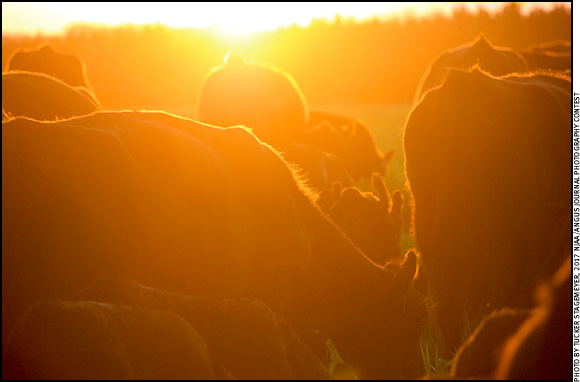HEALTH & NUTRITION...

Avoid Heat Stress When Breeding Cattle
Think ahead for reproductive success.
Julie Walker, beef specialist at South Dakota State University, says working cattle in the hot weather can be detrimental when doing heat synchronization and artificial insemination (AI) programs. Any time you have to move cattle or work cattle, it pays to watch weather forecasts and try to choose a day that won’t be during a heat wave. Sometimes, however, producers need to get cattle in for a heat synchronization program and timing is crucial, regardless of the weather.
More people are going to April-May calving to match forage with nutritional needs of the lactating cow and reduce labor at calving, not having to worry about cold weather in February-March, Walker says, so now they have to deal with the heat instead. They are breeding cows in July and August — which are often the hottest months. Read more.
Notice the Stress
Know the signs of heat stress in your cattle when working them.
On a hot day, cattle overheat quickly if they exert. Moving cattle is always safer during the coolest part of the day, starting early in the morning, if possible. Julie Walker, beef specialist for South Dakota State University, says it’s also important to let cattle go their own speed. Don’t hurry them. Low-stress handling is better, especially if it’s going to be a hot day.
Also watch for signs of heat stress and give cattle a rest if some of them start to overheat.
“The first signs will be fast respiration and panting, breathing with mouth open, and excessive salivation. If you push them farther, you’d see some of them start stumbling and staggering,” she says. Read more.
Controlling Anaplasmosis with Medicated Mineral Supplementation
Zoetis veterinarian explains how to use chlortetracycline to control anaplasmosis.
Anaplasmosis is a disease of cattle that tends to occur most commonly in mature cows and bulls during the summer and early fall. We’ve always thought of it as a disease that mostly affects cattle in the southern tier of states, but with an increase in cattle movement over the last decade, the footprint of anaplasmosis has spread.
Anaplasmosis is caused by Anaplasma marginale, a microorganism that invades red blood cells and causes severe anemia. Transmitted through the blood, the disease is spread by biting flies or ticks or infected blood transferred on contaminated needles or other equipment. Read more.
Delayed Hay Harvest Calls for Testing
Tips offered for collecting accurate hay test samples.
This year’s delayed hay harvest calls for hay testing.
University of Missouri (MU) Extension agronomy specialist Anthony Ohmes says farmers benefit from routine hay testing.
Hay quality varies based on forage species, maturity, management, harvest conditions, and insect or disease damage. Guessing the quality of hay fed to livestock could result in lower profits, Ohmes says. Knowing the hay’s nutrient value can help livestock owners decide if animals need supplements. Read more.
Research Shows Protein on U.S. Native Grasslands in Decline
Scientists are worried protein loss in native grasses is a long-term trend.
There is an alarming trend on America’s rangelands due to grazing and changing climate, and it’s already costing producers almost $2 billion annually, according to recently published work by a Texas A&M AgriLife Research scientist in Temple.
Jay Angerer, an AgriLife Research rangeland ecologist at the Texas A&M AgriLife Research and Extension Center in Temple, recently co-published “Long-term declines in dietary nutritional quality for North American cattle” in Environmental Research Letters with Joseph Craine of Jonah Ventures, Manhattan, Kan.; and Andrew Elmore, University of Maryland Center for Environmental Science, Frostburg, Md. Their research outlines the falling dietary value of forages on unimproved native rangelands in the United States during the past two decades due to nutrient losses associated with grazing and changing climate. Read more.
Waste Not, Want Not
An ethanol industry byproduct makes suitable cattle feed supplement.
Making a living raising cattle isn’t as simple as just buying a herd and turning it out to pasture. Cattle require specific diets to maintain proper nutrition and weight gain. How to do this in the most effective and efficient way possible has interested both ranchers and researchers for generations.
Scientists in Texas are interested in how seasonal change affects the digestibility of a type of Bermuda grass, Tifton 85. In a recent study, they found that as the season progresses, the grass becomes harder to digest. However, by supplementing dried distillers’ grains, this effect can be minimized. Read more.
Next-level Preconditioning Programs
Probiotics keep cattle healthy, help producers earn premiums.
Most cattle must go through the stress associated with weaning. For beef producers, preconditioning can help prepare animals for health challenges that go along with weaning and earn premiums at the same time.
“We know stressful situations like weaning can make calves more vulnerable to disease. Preconditioning is all about building the health of the calf prior to sale time,” says Angel Aguilar, technical services manager, Lallemand Animal Nutrition.
“Preconditioning pays because buyers get healthy calves that are ready to gain on arrival. Today, many producers want to add on to their preconditioning premiums by participating in natural programs or by lessening the costs associated with treatment of disease.”
Read more.
Cattle Diseases: Common Conditions/Terms
Click here for a list of common conditions and terms related to beef cattle diseases, such as anaplasmosis, brucellosis, BVD, E. coli, IBR and others.
[Click here to go to the top of the page.]






